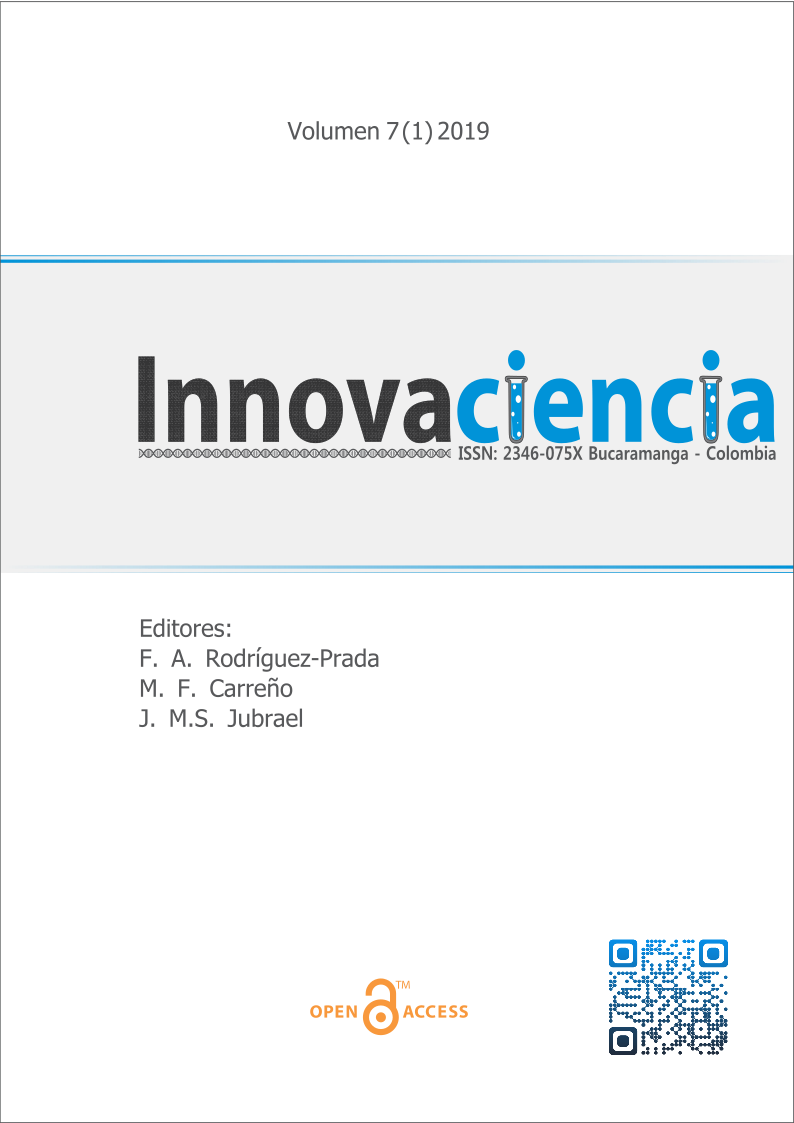Detección de fricción estática basado en el método de redes neuronales artificiales
DOI:
https://doi.org/10.15649/2346075X.692Palabras clave:
static friction, model, static friction, neural networks.Resumen
Introduction: Poor product quality and high energy consumption of
many control loops is due to the presence of static friction. This phenomenon is monitored by human in many industrials. The decision is
made based on human’s brain which is not effective and reliable. Methods: A model-based method of stiction detection based on an artificial
neural network (ANN) is proposed. The ANN which is run in parallel to
the process predicts a dynamic model of the process using data obtained
from control signal and process output. Results: It can be seen that the
proposed method based on ANN can be replaced with human monitoring method. Conclusions: Capability of the proposed method of static
friction detection for the process with the sticky valve is confirmed by
data obtained from the simulation in a control loop with sticky valve.
Referencias
Yamashita Y. An automatic method for detection of valve stiction in process control loops. Control Engineering Practice. 2006; 14(5), 503-510. https://doi.org/10.1016/j.conengprac.2005.03.004.
Daneshwar M. A., Noh N. M. Identification of a process with control valve stiction using a fuzzy system: a data-driven approach'', Journal of Process Control. 2014; 24, 249-260. https://doi.org/10.1016/j.jprocont.2014.01.013
Daneshwar M. A., Noh N. M. Detection of stiction in flow control loops based on fuzzy clustering'', Control Engineering Practice. 2015; 39, pp. 23-34. https://doi.org/10.1016/j.conengprac.2015.02.002
Aminifar S., bin Marzuki A. Horizontal and vertical rule bases method in fuzzy controllers. Mathematical Problems in Engineering, 2013.http://dx.doi.org/10.1155/2013/532046. https://doi.org/10.1155/2013/532046
Aminifar S., Marzuki A. Uncertainty in interval type-2 fuzzy systems. Mathematical Problems in Engineering, 2013. http://dx.doi.org/10.1155/2013/452780
Marzuki A., Tee S.Y., Aminifar S. Study of fuzzy systems with Sugeno and Mamdanitype fuzzy inference systems for determination of heartbeat cases on Electrocardiogram (ECG) signals'', International Journal of Biomedical Engineering and Technology. 2014; (3), 243-276. https://doi.org/10.1504/IJBET.2014.059673
Maghdid H. S. and Lami I. A. Dynamic clock-model of Wi-Fi access-points to help indoors localisation of smartphones," 2012 IV International Congress on Ultra Modern Telecommunications and Control Systems, St. Petersburg, 2012, pp. 268-273. doi: 10.1109/ICUMT.2012.6459677. https://doi.org/10.1109/ICUMT.2012.6459677
Lami I. A. and Maghdid H. S. SynchronisingWiFi access points with GPS time obtained from smartphones to aid localization. 2013 International Conference on Computer Applications Technology (ICCAT), Sousse, 2013, pp. 1-6. doi: 10.1109/ICCAT.2013.6522052. https://doi.org/10.1109/ICCAT.2013.6522052
Sabir A., Ahmed M., Faeq A., and Maghdid H. Human gait identification using Kinect sensor", Kurdistan Journal of Applied Research. 2017; 2(3), 142-146. https://doi.org/10.24017/science.2017.3.37
Maghdid S. A., Maghdid H. S., HmaSalah S. R., Ghafoor K. Z., Sadiq A. S., Khan S. Indoor human tracking mechanism using integrated onboard smartphones Wi-Fi device and inertial sensors. Telecommunication Systems. 2018; pp.1-12. https://doi.org/10.1007/s11235-018-0517-2.
Maghdid H. S. Web News Mining Using New Features: A Comparative Study. IEEE Access. 2019; 7, 1-16. https://doi.org/10.1109/ACCESS.2018.2890088
Choudhury M.A.A.S., Jain M., Shah S. L.Stiction definition, modelling, detection and quantification''. Journal of Process Control.2008; 18(3-4), 232-243. https://doi.org/10.1016/j.jprocont.2007.07.004.
YosefiG., AminifarS., NedaS., DaneshwarM.A. Design of a mixed-signal digital CMOS fuzzy logic controller (FLC) chip using new current mode circuits''AEU-International Journal of Electronics and Communications.2011; 65 (3), 173-181. https://doi.org/10.1016/j.aeue.2010.01.019
Daneshwar M. A, Noh N. M. Valve stiction in control loops-A survey on effective methods of detection and compensation''2012 IEEE International Conference on Control System, Computing and Engineering. 2012, pp.155-159. https://doi.org/10.1109/ICCSCE.2012.6487133
Tavoosi J., Jokandan A. S., Daneshwar M. A. A new method for position control of a 2-DOF robot arm using neuro-fuzzy controller, Indian Journal of Science and Technology. 2012; 5 (3), 2253-2257.
Ljung L. System identification: theory for the user. Prentice Hall PTR, 1999.

Descargas
Publicado
Cómo citar
Número
Sección
Altmetrics
Descargas
Licencia
Todos los artículos publicados en esta revista científica están protegidos por los derechos de autor. Los autores retienen los derechos de autor y conceden a la revista el derecho de primera publicación con el trabajo simultáneamente licenciado bajo una Licencia Creative Commons Atribución-NoComercial 4.0 Internacional (CC BY-NC 4.0) que permite compartir el trabajo con reconocimiento de autoría y sin fines comerciales.
Los lectores pueden copiar y distribuir el material de este número de la revista para fines no comerciales en cualquier medio, siempre que se cite el trabajo original y se den crédito a los autores y a la revista.
Cualquier uso comercial del material de esta revista está estrictamente prohibido sin el permiso por escrito del titular de los derechos de autor.
Para obtener más información sobre los derechos de autor de la revista y las políticas de acceso abierto, por favor visite nuestro sitio web.




















